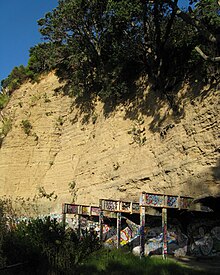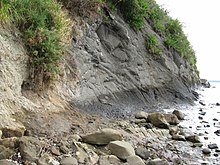
Achilles Point (Te Pane o Horoiwi – The head of Horoiwi) is a rocky point on the headland at the eastern end of the small sandy beach named Ladies Bay, Auckland, New Zealand. The name 'Te Pane o Horoiwi' can also sometimes refer to the whole headland between St Heliers and Tamaki River estuary. Achilles Point is named after a ship called HMNZS Achilles (70) which defeated the German pocket battleship Admiral Graf Spee in 1939. The headland, from the point round to the Tamaki heads, was previously known as Te Pane o Horoiwi, named after Horoiwi who arrived in New Zealand on the Tainui canoe (waka).

Ladies Bay is a secluded beach, below steep cliffs, on the headland west of the lookout over Achilles point. Both Ladies Bay and further to the east, the more secluded Gentleman's Bay beach are unofficially places where nudists can often be found enjoying the sun and sand however the fine for indecent exposure is $200. The secluded bays are also popular with the male gay community.
Glover Park is an ancient volcanic crater which erupted more than 45,000 years ago. The volcanic tuff ring crater is also known in Māori language as Whakahumu or geologically as the 'St Heliers explosion crater'. It is found in the center of the headland between West Tamaki Head and the eastern end of St Heliers Bay beach. It was filled in during the 1950s to form a public sports field. Before that it formed a seasonal shallow lake or swamp.

The seaward side of the tuff crater is falling away down the coastal cliffs to 'Gentleman's Bay' far below. The tuff ring is made from ash and ejected material. The cliffs were there before the volcano erupted so the volcanic rock draped over the clay hill that once existed before sea levels rose and began eroding it away to become the steep cliffs we see today. Some volcanic rocks can be found on the beach below – some fragments ejected from deep in the earth, or blocks of tuff ring that were once perched on top of the cliff. Rangitoto Island is directly to the north, however Rangitoto is a recent eruption (600 to 550 years ago) and was not always there to shelter the cliffs from powerful wave action. There is an old concrete water tower built on the tuff ring formed around the edge of the crater opposite the seaward side.
Geology

Going east, past Ladies Bay and Gentleman's Bay, we round the West Tamaki Head into the Tamaki Estuary. It is here we find an excellent example of the grey coloured 'Parnell Grit' accessible from Karaka Bay. 'Parnell Grit', is a brittle sedimentary rock containing fragments of scoria, andesite, and pumice.
At low tide there is an interesting walk from Ladies Bay along the base of the cliffs to St Helier's Bay. The rocky shoreline overlooks the Waitemata Harbour which itself occupies a drowned valley system cut in marine sediments of Miocene Age (15–25 million years ago). Generally, around Auckland these soft Miocene sediments are alternating Waitemata series sandstone and mudstone with more massive beds of sandstone sometimes with minor occurrences of limestone. The concretions that can be easily seen, are formed by the action of ground water with dissolved minerals (mainly calcium carbonate of which limestone is made) percolating through the layers. Calcium carbonate is an important component of concrete and fills in the pore spaces between grains of sediment thereby cementing the grains together and making them more durable against erosion.
Glover Park volcano formed from a phreatomagmatic eruption leaving a basaltic monogenetic volcanic crater up to 300 m (980 ft) in maximum diameter, surrounded except to the north-east by tuff deposits that extend about 500 m (1,600 ft) to the east and south. The presence of overlying Rotoehu tephra on a drill ore means the volcano last erupted more than 45,000 years ago, but the age is unclear within a wide range. The cliff retreat with raising sealevels of Achilles Point has meant, as already mentioned, that the tuff deposits 30 m (98 ft) up the cliffs, as they erode, fall onto the sea rock platform (see photos below). This has resulted in the discovery that a distinctive lithic clast in the tuff that contained shell fragments was strong evidence that the erupted magma traversed the eastern border of the ophiolitic Dun Mountain-Maitai Terrane.
References
- MacIntyre, Jenny (10 February 2008). "'Dirty blokes' ruining bare-all bay". The New Zealand Herald. Retrieved 15 September 2011.
- ^ Spörli, K. B.; Black, P. M.; Lindsay, J. M. (2015). "Excavation of buried Dun Mountain–Maitai terrane ophiolite by volcanoes of the Auckland Volcanic field, New Zealand". New Zealand Journal of Geology and Geophysics. 28 (3): 229–243. doi:10.1080/00288306.2015.1035285.
- Devora (2020). Rangitoto: Odd one out. The story of Auckland's largest volcano. Devora Fact Sheet 03."DEVORA Fact Sheet 3 - Rangitoto: Odd One Out". Retrieved 9 December 2023.
- Geological Map of New Zealand
- Volcanoes of Auckland: A Field Guide. Hayward, B.W.; Auckland University Press, 2019, 335 pp. ISBN 0-582-71784-1.
External links
- Archaeology and History of St Heliers, Auckland.
- Geology of the headland
- Point to point walkway ARC – St Heliers to Churchill park through the crater at Glover Park
- Explanation of concretions
- Point to Point walkway. The full point to point walk is approximately 7.5km long, starting at the popular St Heliers Bay and finishing at Point England. Allow three to four hours.
Gallery
- Geological features between Ladies Bay and St Heliers Bay
-
 Sandstone and mudstone layers
Sandstone and mudstone layers
-
 Close up of white siltstone in cliff.
Close up of white siltstone in cliff.
-
 White rock broken away
White rock broken away
-
 Discoloration of crumbling white siltstone layer.
Discoloration of crumbling white siltstone layer.
-
 Cross-section of concretion snapped off at cliff wall.
Cross-section of concretion snapped off at cliff wall.
-
 Concretions all line up in the cliff wall.
Concretions all line up in the cliff wall.
-
1859 map showing the volcanoes and lava flows. Glover Park volcano is to the upper right on the shores of the Waitematā Harbour.
-
 The rocks between the point and St Heliers Bay. Layers of sedimentary rock strata.
The rocks between the point and St Heliers Bay. Layers of sedimentary rock strata.
-
 The rocks between the point and St Heliers Bay. White siltstone layer.
The rocks between the point and St Heliers Bay. White siltstone layer.
-
 The rocks between the point and St Heliers Bay. The concretions are scattered and looking like fossilised logs, long after the supporting sandstone has been eroded away by the waves.
The rocks between the point and St Heliers Bay. The concretions are scattered and looking like fossilised logs, long after the supporting sandstone has been eroded away by the waves.
-
 The projections are known as concretions and are all on the same horizontal layer. Sometimes they might snap off. More often, the softer stone erodes away completely, leaving them resting on the surface a few meters lower.
The projections are known as concretions and are all on the same horizontal layer. Sometimes they might snap off. More often, the softer stone erodes away completely, leaving them resting on the surface a few meters lower.
-
 Close up of sandstone and mudstone layers
Close up of sandstone and mudstone layers
-
 Achilles Point from the viewing platform - looks like the bow of a ship.
Achilles Point from the viewing platform - looks like the bow of a ship.
-
 Ladies Bay
Ladies Bay
-
 Glover Park crater with housing and water tower on the tuff ring
Glover Park crater with housing and water tower on the tuff ring
36°50′36″S 174°51′50″E / 36.843390°S 174.863800°E / -36.843390; 174.863800
| Ōrākei Local Board Area, Auckland, New Zealand | |
|---|---|
| Populated places | |
| Geographic features | |
| Facilities and attractions | |
| Government | |
| Organisations | |